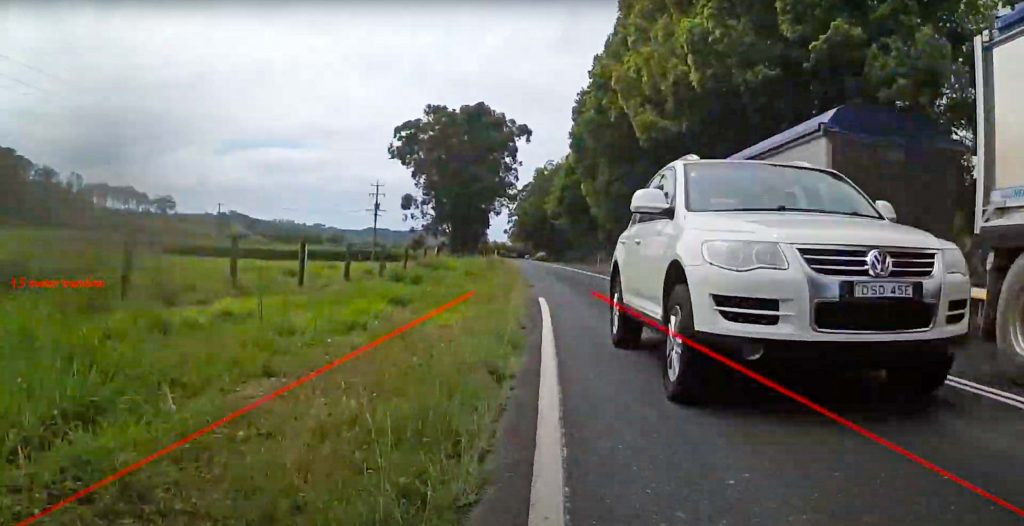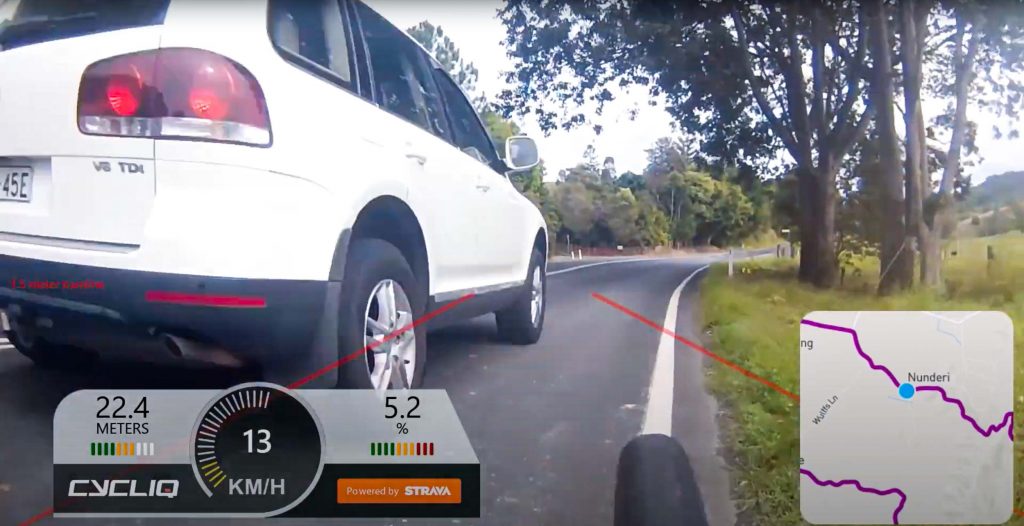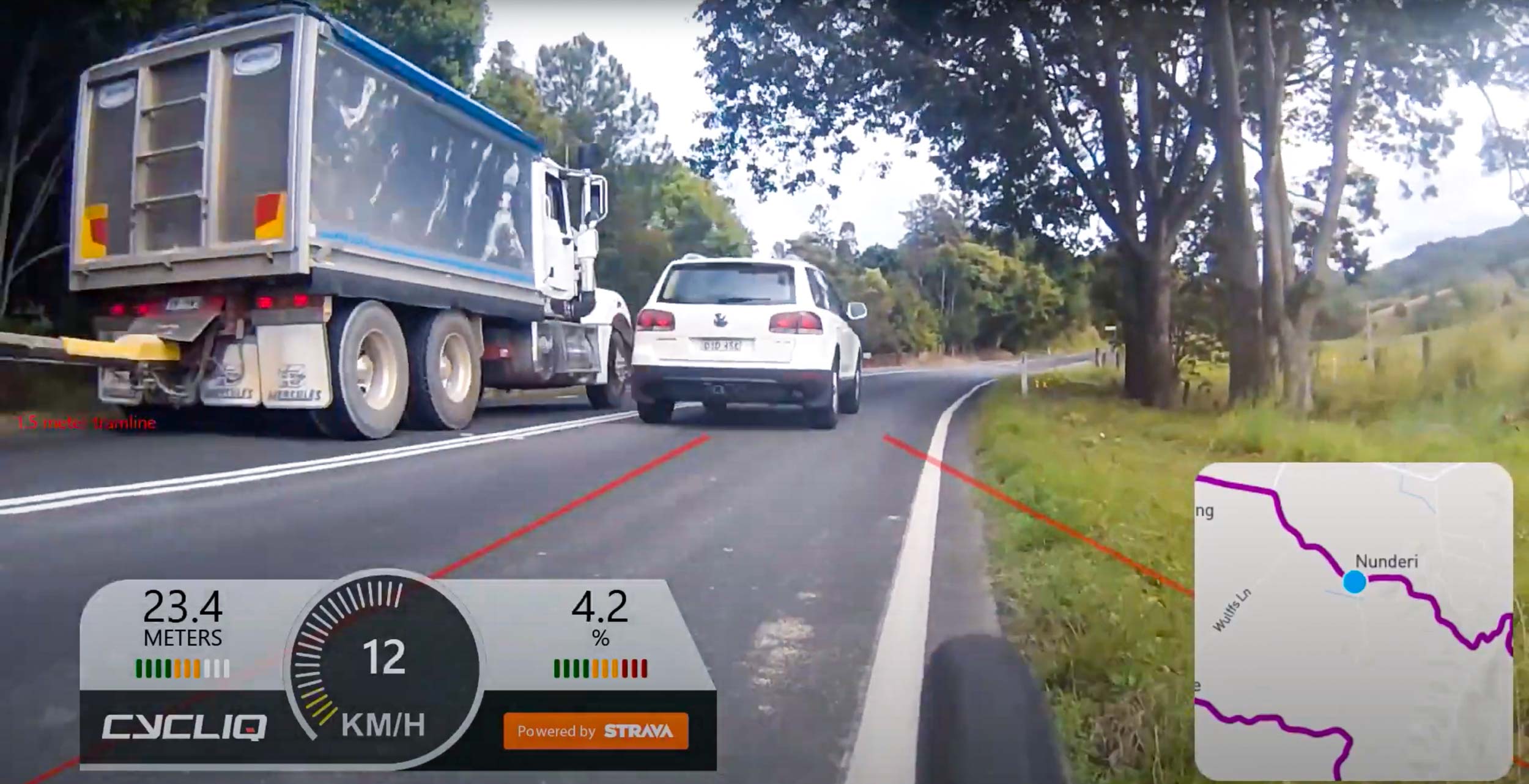There is technology at our disposal that should, in theory, make cycling safer. But as this story highlights, not even solid evidence of dangerous driving will guarantee that the police will take appropriate action.
– By Rob Arnold
There has been a strong response to a ‘Story of my ride’ video about a dangerous moment involving a motorist on the weekend. Amongst the reactions is a story about a similar incident in northern NSW from September 2021, explained by Peter Whittle who is pursuing action against a driver that overtook a B-double truck and almost caused a head-on collision.
The footage explains the circumstances perfectly and it’s very disturbing (see the YouTube clip, above).
While negotiating a sweeping left-hander near Nunderi, Whittle rides on the white line at the far left of his lane. Ahead of him is a large truck approaching at speed. From behind the truck a VW 4WD begins an overtaking manoeuvre despite the two lanes clearly being divided with double solid lines (ie. no passing allowed).
Whittle’s footage is collected via front and rear Cycliq video cameras, detailing speed, gradient, and location, while also showing the ‘1.5 metre tramline’ to illustrate the proximity to the bike on which the cameras are positioned.

It is quite clearly dangerous driving. Even if Whittle hadn’t been where he was at the time the VW overtook the truck, you’d expect that police would take action against the driver based on the reality that he crossed double solid lines to pass. Alas, after five months of diligent follow-up, no charges have been laid and the driver remains at large, without any consequences for his actions.
Evidence collected, now what?
When people read my explanation of an incident in the Royal National Park south of Sydney, several offered comments advising that video footage of the incident would be beneficial and, in an ideal world, lead to charges being laid for dangerous driving.
Unfortunately, as Whittle has told RIDE Media, it’s not always that simple. Months have passed and the cyclist continues to pursue NSW police in the hope that he’ll get a response from his footage. To date, no action has been taken against the VW driver even though the footage leaves no room for doubt about what took place.

Making matters worse is the fact that Whittle was also able to track down the driver of the truck, and he also has footage recorded of the incident from a dashcam (which RIDE Media has not yet sighted).
There have been numerous follow-up exchanges with the NSW police and Whittle continues to be given the run-around, with a range of excuses offered for why no action has been taken.
At the very least, the charge of ‘driving in a manner dangerous’ could be pursued but the police have told Whittle that the footage from his Cycliq cameras couldn’t be used as evidence as it “lacked a date stamp”. Furthermore, they explained, they would ideally also like to see footage collected from the truck’s dashcam.
As the images showcase, Whittle is also on Strava and he has the date, time and place recorded to highlight when and where the dangerous overtaking move happened so the police excuse for a lack of action becomes a little more bewildering.
Adding to what appears to be a clear case of apathy from the NSW police is the fact that the truck driver not only delivered the dashcam footage, he also provided a statement about the incident at a police station.
Despite all the work Whittle has undertaken to follow up on this frightening incident, the police have failed to provide an adequate response.

The initial police response
When Peter Whittle initially reported the incident, the police insisted that the additional dashcam footage would be required before they could take any action. The assumption from many would be that the police would therefore attempt to contact the truck driver to ascertain if he had any footage. But that didn’t happen.
Instead, it was Whittle himself who, after posting the YouTube clip on local social media accounts, tracked down the driver. They spoke and the truckie explained that he had the vision and that he was prepared to give a statement, and he subsequently did so at the local police station.
Still nothing happened. After weeks of silence, Whittle again contacted police to find out how their investigation was going. It had stalled – or, at least, there was nothing to report.
The rear number plate of the offending VW vehicle is clearly visible and, you’d think, that should surely be enough for police to track down the driver and question them about what is, quite obviously, extremely dangerous driving. Again, nothing.
As far as Whittle knows, the driver has never been contacted.
No online reporting with NSW police
The Tweed shire is in NSW but close to the Queensland border and Peter Whittle has dealt with police in both states. In Queensland it’s possible for cyclists to report traffic incidents with an online system, but there is no equivalent in NSW. Instead, Whittle has had to attend the station to give his statements.
Although over five months have passed and much of the investigative work done by the cyclist, the driver remains at large.
Whittle hasn’t conceded but he is baffled by the apparent lack of police interest in his case. He very nearly had a head-on with a fast-moving vehicle that was on the wrong side of the road. He recorded the close call with two cameras and personally acquired dashcam footage to support his complaint but, it would seem, it’s not enough to press charges.
* * * * *
There is aggression on our roads, and there are rules in place that are supposed to minimise risk. Alas, as this story highlights, all too often there is inaction and complacency rather than charges being laid in the hope of deterring dangerous behaviour.
Peter Whittle should not have had to watch as a vehicle sped towards him in a life-threatening situation. He should not have had to follow up with the truck driver and collect evidence that the police insisted was necessary. He should not have to make multiple calls to find out why the driver remains free from ramification. And he should be able to feel safe when he rides his bike on public roads.
– By Rob Arnold


